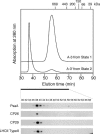Identification of the mobile light-harvesting complex II polypeptides for state transitions in Chlamydomonas reinhardtii
- PMID: 16407170
- PMCID: PMC1326185
- DOI: 10.1073/pnas.0509952103
Identification of the mobile light-harvesting complex II polypeptides for state transitions in Chlamydomonas reinhardtii
Abstract
State transition in photosynthesis is a short-term balancing mechanism of energy distribution between photosystem I (PSI) and photosystem II (PSII). When PSII is preferentially excited (state 2), a pool of mobile light-harvesting complex II (LHCII) antenna proteins is thought to migrate from PSII to PSI, but biochemical evidence for a physical association between LHCII proteins and PSI in state 2 is weak. Here, using the green alga Chlamydomonas reinhardtii, which has a high capacity for state transitions, we report the isolation of PSI-light-harvesting complex I (LHCI) super-complexes from cells locked into state 1 and state 2. We solubilized the thylakoid membranes with a mild detergent, separated the proteins by sucrose density gradient centrifugation, and subjected gradient fractions to gel-filtration chromatography. Three LHCII polypeptides were associated with a PSI-LHCI supercomplex only in state 2; we identified them as two minor monomeric LHCII proteins (CP26 and CP29) and one previously unreported major LHCII protein type II, or LhcbM5. These three LHCII proteins, in addition to the major trimeric LHCII proteins, were phosphorylated upon transition to state 2. The corresponding phylogenetic tree indicates that among the LHCII proteins associated with PSII, these three LHCII proteins are the most similar to the LHC proteins for PSI (LHCI). Our results are important because CP26, CP29, and LhcbM5, which have been viewed as belonging solely to the PSII complex, are now postulated to shuttle between PSI and PSII during state transitions, thereby acting as docking sites for the trimeric LHCII proteins in both PSI and PSII.
Figures






Similar articles
-
Biochemical characterization of photosystem I-associated light-harvesting complexes I and II isolated from state 2 cells of Chlamydomonas reinhardtii.Plant Cell Physiol. 2014 Aug;55(8):1437-49. doi: 10.1093/pcp/pcu071. Epub 2014 May 26. Plant Cell Physiol. 2014. PMID: 24867888
-
CP29, a monomeric light-harvesting complex II protein, is essential for state transitions in Chlamydomonas reinhardtii.J Biol Chem. 2009 Mar 20;284(12):7777-82. doi: 10.1074/jbc.M809360200. Epub 2009 Jan 13. J Biol Chem. 2009. PMID: 19144643 Free PMC article.
-
A model for the 77K excited state dynamics in Chlamydomonas reinhardtii in state 1 and state 2.Biochim Biophys Acta Bioenerg. 2017 Jan;1858(1):64-72. doi: 10.1016/j.bbabio.2016.10.001. Epub 2016 Oct 21. Biochim Biophys Acta Bioenerg. 2017. PMID: 27777037
-
Structural analysis and comparison of light-harvesting complexes I and II.Biochim Biophys Acta Bioenerg. 2020 Apr 1;1861(4):148038. doi: 10.1016/j.bbabio.2019.06.010. Epub 2019 Jun 20. Biochim Biophys Acta Bioenerg. 2020. PMID: 31229568 Review.
-
Dynamic Regulation of the Light-Harvesting System through State Transitions in Land Plants and Green Algae.Plants (Basel). 2023 Mar 3;12(5):1173. doi: 10.3390/plants12051173. Plants (Basel). 2023. PMID: 36904032 Free PMC article. Review.
Cited by
-
The photosystem II light-harvesting protein Lhcb3 affects the macrostructure of photosystem II and the rate of state transitions in Arabidopsis.Plant Cell. 2009 Oct;21(10):3245-56. doi: 10.1105/tpc.108.064006. Epub 2009 Oct 30. Plant Cell. 2009. PMID: 19880802 Free PMC article.
-
Involvement of Lhcb6 and Lhcb5 in Photosynthesis Regulation in Physcomitrella patens Response to Abiotic Stress.Int J Mol Sci. 2019 Jul 26;20(15):3665. doi: 10.3390/ijms20153665. Int J Mol Sci. 2019. PMID: 31357454 Free PMC article.
-
Distribution and dynamics of electron transport complexes in cyanobacterial thylakoid membranes.Biochim Biophys Acta. 2016 Mar;1857(3):256-65. doi: 10.1016/j.bbabio.2015.11.010. Epub 2015 Nov 24. Biochim Biophys Acta. 2016. PMID: 26619924 Free PMC article. Review.
-
Micelle-induced folding of spinach thylakoid soluble phosphoprotein of 9 kDa and its functional implications.Biochemistry. 2006 Dec 26;45(51):15633-43. doi: 10.1021/bi062148m. Epub 2006 Dec 8. Biochemistry. 2006. PMID: 17176085 Free PMC article.
-
The key cyclic electron flow protein PGR5 associates with cytochrome b6f, and its function is partially influenced by the LHCII state transition.Hortic Res. 2021 Mar 4;8(1):55. doi: 10.1038/s41438-021-00460-y. Hortic Res. 2021. PMID: 33664242 Free PMC article.
References
-
- Dekker, J. P. & Boekema, E. J. (2005) Biochim. Biophys. Acta 1706, 12-39. - PubMed
-
- Murata, N. (1969) Biochim. Biophys. Acta 172, 242-251. - PubMed
-
- Bonaventura, C. & Myers, J. (1969) Biochim. Biophys. Acta 189, 366-383. - PubMed
-
- Haldrup, A., Jensen, P. E., Lunde, C. & Scheller, H. V. (2001) Trends Plant Sci. 6, 301-305. - PubMed
Publication types
MeSH terms
Substances
LinkOut - more resources
Full Text Sources
Molecular Biology Databases

